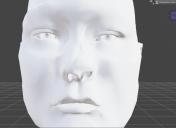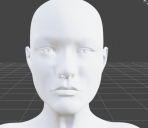Daz to Hex Face Transer fix morph?
Hello,
I have had Daz for years but really only played with it on occasion and have recently been trying to use and understand it more. I have been toying with the Face Transfer and then sending the model to Hex to try and sculpt it to be more accurate. I hope someone can explain why this is just not working. I generated a face using the face transer and then dialed in some of the features to match my likenes a bit more, but it seems the sliders have their limits on getting a good likeness. I removed all the base materials from the model and sent it to Hex to try and sculpt and fine tune the face just trying one feature at a time. I can get it pretty spot on through sculpting, but when I try to send from Hex back to Daz as a morph - it doesn't seem to change the model at all. I get the morph slider, but when I try to use that slider - it just looks all kinds of distorted and wrong. What am I doing wrong? is this even possible? Thanks in advance for any advice!








Comments
What options are you seelcting in sending to/returning from Hexagon? It looks as if it may not be reversing out the existing morphs - have you tried zeroing the shape (Edit>Figuer>Zero>Zero Figuer Shape) and then applying the morph?
Face Transfer is sent to Hexagon for further changes. Okay.
Back in D/S clear the scene and load a fresh G8, base resolution, NO eyelashes. Have it selected.
Make the changes you want in Hexagon, then send it back to D/S and give the morph a unique name.
Reverse Deformations [always a good idea].
Dial in the morph, if you like it, zero it and save it.
[remember to put G8 back to High Resolution].
That did it! Thanks. I think I had the process confused in my head and was afraid that if I zeroed the figure shape I would loose the closeness in likeness I had achieved up to that point from just the sliders... didn't really consider that topology was kind of preserved when I sent it from Daz to Hex and trying to send it back I was kind of like.. overlapping or doubling it. I know I'm not using the right terminology but I can see where my thinking was off anyways lol. thanks so much for the nudge in the right direction!!
so sorry , I feel like this is such a noob question, but I gotta ask because I want to get better at this. I didn't even realize I could change the resolution of the model. I see now where I can change that, but, what does that do? Does that increase the number of verticies and faces? Should I set the resolution to high before sending it to Hex? Or just leave it as base until I'm ready to render, then set it to high res? Does setting the model to high resolution make for better renders?
We have to make morphs on the base resolution mesh, the SubD process adds additional polygons and smooths the shape.
Geenrally you would want to reverse the effects of the existign morphs (or poses) out of the new morph - it keeps any links to corrective morphs and is safe to share. However it did appear that wasn't been done automatically here. If you go to Edit>Preferencs (Daz Studio>Preferences for a Mac) the bridges tab does have an option to show more advanced options when bridging to Hexagon.